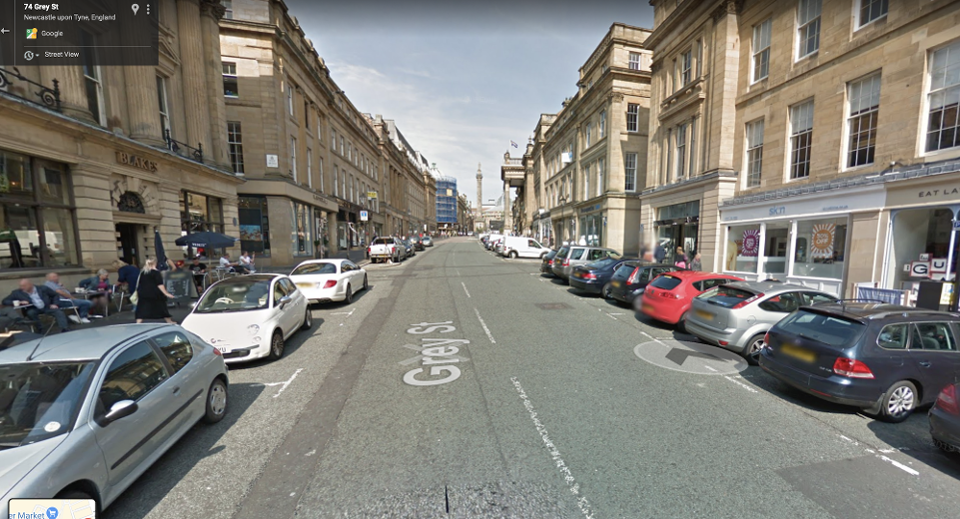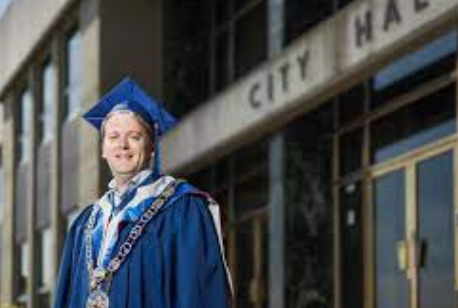
I have been writing about Open Streets, and how they are being used Post-Covid to make accessing services more comfortable for walkers, rollers and cyclists going to shops and services. There’s also a positive impact of Open Streets for businesses. Open Streets allow for wider sidewalk areas, making customers feel better about standing in line to access a business with appropriate physical distancing. This provides enough space to wait on the street without getting too close to someone simply walking by on a sidewalk.
The term “Open Streets’ refers to temporarily closing streets to through traffic, but filtering necessary local traffic, emergency vehicles, public transit, pedestrians, rollers and cyclists. Open Streets also provide separate road space for traditional sidewalk users who are going at a different pace than cyclists. Creating Open Streets also allows commercial businesses to use more of the sidewalk or the road way to conduct their business given the new physical distancing requirements.
There has been a concern that while the concept of open streets to facilitate movement during Covid times was admirable, what would happen if open streets became permanent? And isn’t that bad for business?
This is the truth about Open Streets. If people are accessing services through a filtered network that allows for expanded space for only transit, walkers, rollers and cyclists, each of those individuals represent one less vehicle on the road. Vehicle drivers win because there is less congestion.
And the data shows that businesses win too. This study done by Transport for London shows that people walking, rolling and cycling and using public transport spend 40 percent more each month than car drivers. These numbers have also been replicated in studies in Toronto and in New York City.
In London time spent on retail streets increased by 216% between shopping, patronizing local cafes and sitting on street benches. Retail space vacancies also declined by 17%.
There is also an interest in thinking through shops and services at a local neighbourhood scale too where sidewalks are less crowded. These areas could also benefit from Open Streets. As local historian John Atkin notes on twitter “Thinking city structure, sidewalk crowding, community & ‘bubbles’. Lose exclusionary zoning, allow local retail pockets so we don’t overload the arterials. I haven’t had to trek outside Strathcona because we have 2 great shops + coffee to walk to.”
Creating “bubbles” of services within an easy walking or biking distance in each neighbourhood adds a level of local resiliency. It’s something we have zoned out of areas, making existing non-conforming retail pockets~like the one at 33rd and Blenheim in Dunbar~such an asset. The ability to access these commercial areas safely with cycle, walking or transit a priority would be a neighbourhood asset.
While cities around the world are developing filtered streets to accommodate the post Covid recovery, that’s no plan from Vancouver yet.
Here’s another example of great work in the City of Newcastle Great Britain as written by Carlton Reid with Forbes.com. Newcastle which is bisected by a highway system wanted to “reassert the supremacy of the city over its traffic.” They embraced the chance to make a downtown plan that was “not anti-car, but pro-city”, ensuring that residents could easily and comfortably use their downtown and related businesses. Here’s how they did it.
Their Open Street temporary changes include widening sidewalks, reallocating road space for walking and cycling, and creating space for lining up for business access. Motor vehicles will have one way usage of the road space, giving sidewalk users five more meters of space. Pocket parks will be tucked into road spaces, and vehicular traffic speed will be reduced. Dependent on the effectiveness of these measures, they will be extended into neighbourhoods across the city in 2021.
In the words of Newcastle Council member Nick Forbes: It’s important that our immediate focus is on how people can safely move around with proper social distancing and space to walk and cycle, which people are choosing to do in increasing numbers. We will be looking closely at how these short term and essential measures that we are introducing now can help us move towards the city that we want future generations to be able to enjoy.”
That’s how City Council can support a resilient post-Covid city that lets residents and businesses thrive.
Below the before and the after for Newcastle’s commercial Grey Street.


Images: Forbes.com












I certainly support open streets, but i think that a transportation network approach needs to be taken.
It seems obvious that if one well-used street, such as robson, is turned into an open street, then there will be increased vehicle traffic on adjacent parellel streets, if nothing is done to control it.
Likewise, traffic will increase on intersecting streets.
Even more, as businesses see the benefits of open streets, such as expanded sidewalk patios, they will want them too. I could see a trend whereby more and more streets in a commercial area such as downtown vancouver, become open streets over time.
Of couse this would be good for pedestrians and cyclists and their access to certain businesses, but the more it expands, the more ipacts it will have one the total transportation network. I could see an outcome where someone who works downtown having to drive significantly further just to access a downtown parking garage.
Not necessarily a bad thing, but it should be considered,
When you reduce capacity for motor vehicles, traffic disappears. So it’s not a sure thing that if you open one street to pedestrians/bikes and/or transit that other streets will see increases in MV traffic. Furthermore, the more streets that are closed to motor vehicles the fewer MV crossings there would be, potentially improving MV traffic flow somewhat on the streets they still have access to.
Certainly crossing pedestrians, bikes and transit would still impede their flow, but they wouldn’t be impeding each other with crossings and turns in their big, inefficient, lumbering machines. I don’t think one should underestimate how big a factor that is.
Adam fitch wrote: “It seems obvious that if one well-used street, such as robson, is turned into an open street, then there will be increased vehicle traffic on adjacent parellel streets, if nothing is done to control it.”
My biggest beef with Robson Street is how the closure messes up the Robson bus route. I’d much rather see it configured like Granville Mall – prohibited for all vehicles except buses.
Except that Granville Mall has only been modestly successful at best – and I’d suggest it’s because of the buses. Not necessarily the buses themselves but that once you have a road space at all it will be infiltrated (as it is) with emergency vehicles, delivery trucks, taxis, lost tourists and belligerent motorists who know they’ll get away wit it 99% of the time.
It doesn’t feel like a street open to pedestrians. It doesn’t have much in the way of quality spaces to linger.
I’d open up much more of Robson and shift the buses to Alberni.
Granville mall needs trees and garden separating the transit lanes pedestrians would cross one lane at a time
Crossing the street is not really the problem. Even with all the non-transit traffic it isn’t that it is a particularly busy road. And it is just two lanes. But it just doesn’t feel like a pedestrianized street. Wide sidewalks, haphazard benches. That’s about it. Nothing pleasant about hanging out. The only people who linger are the homeless.
agreed crossing the street is not a problem but Granville is ugly ….,.. with 3 m sidewalk……,. a 3m transit lane. on each side & 8m of park, trees& garden in the middle it would be pleasant
belligerent motorists get away with it because it is not policed..,. even though the revenue from fines would be more than costs,…… I f fines don t cover costs then it is probably not a problem